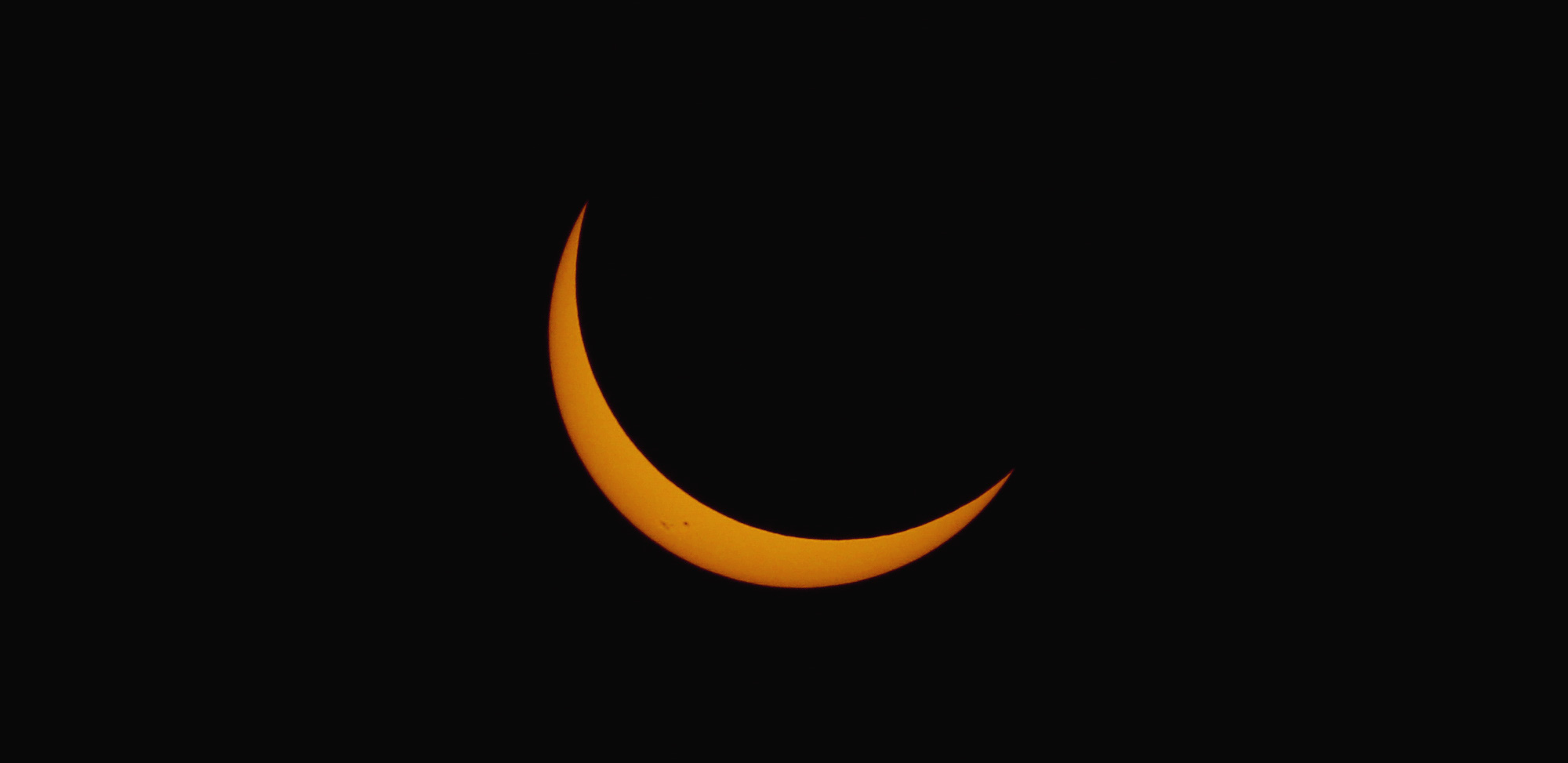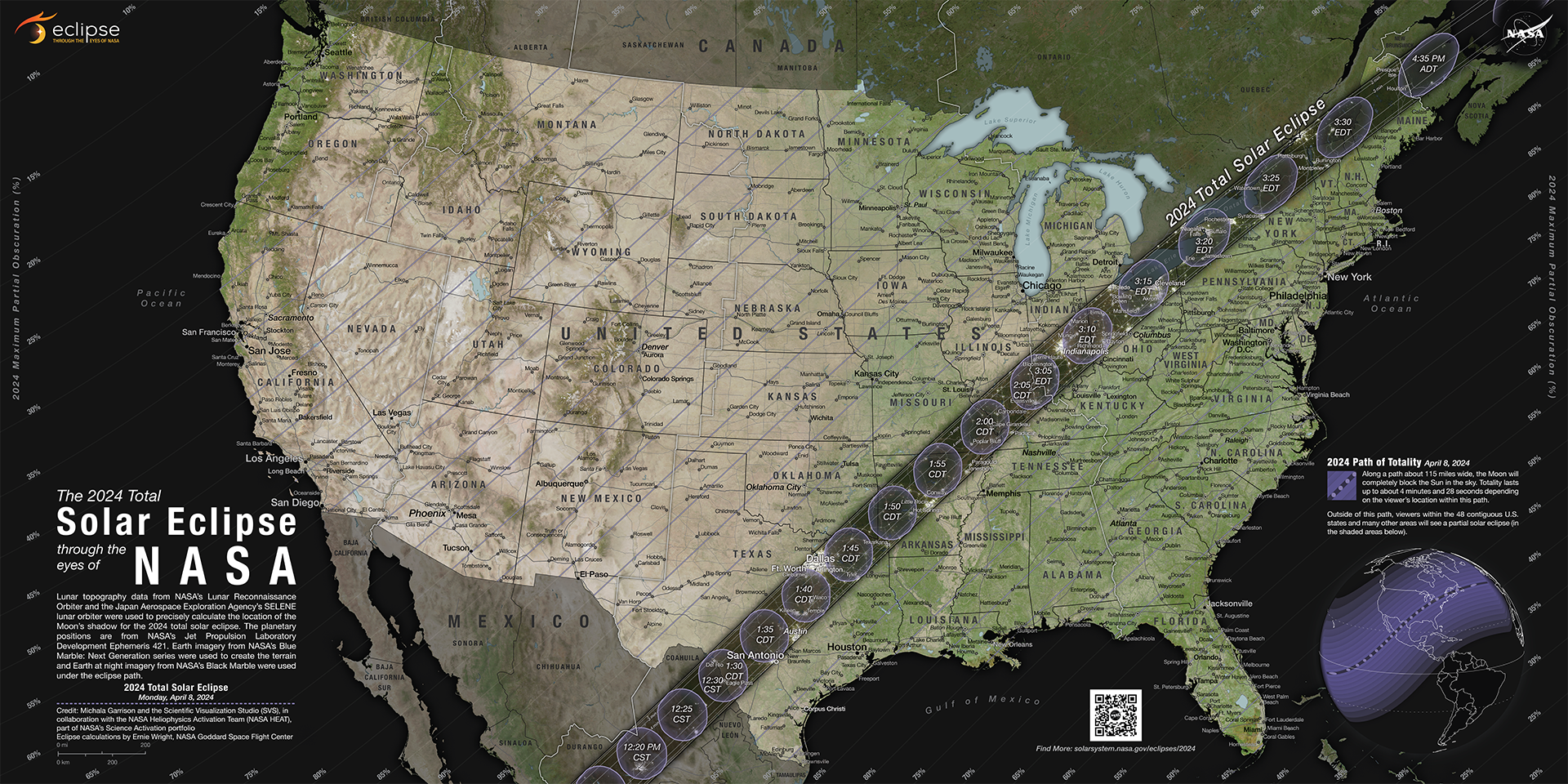
Partial Solar Eclipse Over Rhode Island: April 8, 2024
April 2024 :
On Monday, April 8, 2024, a total solar eclipse will transect North America. This is the second solar eclipse in six months (the first being the annular eclipse of October 14, 2023), and the first total eclipse in the US since August 21, 2017.
A solar eclipse occurs whenever the Moon, in its 29.5-day (synodic) orbit, passes between Earth and the Sun. Even though solar eclipses only occur during New Moon, not every New Moon results in a solar eclipse. This is due to the Moon’s orbit being inclined by about 5° relative to the ecliptic, the plane of Earth’s orbit around the Sun. While this angle may seem small, the distance to the Moon, between 28 and 32 times the radius of Earth, causes the Moon to “miss” the Sun by invisibly passing too far north or south of our star to block any part of it as seen from Earth, most of the time. But, on average, slightly more frequent than once per year, the alignment is just right for a solar eclipse to occur somewhere on Earth. Slightly less frequent, however, this results in a total eclipse, when, over a small slice of Earth’s surface, the entire Sun is blocked by the Moon.
Another factor in determining whether a total eclipse can be seen is the distance to the Moon. As the orbit of the Moon, like every other celestial object, is not perfectly circular, but elliptical, the distance varies over the course of its orbit. In the case of the Moon, that distance varies by approximately 11%, from about 28 to 32 times Earth’ radius. The varying distance changes the apparent diameter of the Moon in the sky. If the Moon passes directly between Earth and the Sun when it is at its farthest distance, known as apogee, it will not be large enough to cover the entire disk of the Sun. Anyone along the centerline of this eclipse would witness an annular eclipse, where a narrow ring of sunlight surrounds the Moon at maximum eclipse. This is what occurred on October 14, 2023.
To a lesser extent, the Sun’s varying apparent diameter resulting from Earth’s changing distance can determine whether we see an annular or total eclipse.

During the April 8 eclipse, observers in Rhode Island do not experience totality, when 100% of the Sun is obscured by the Moon. No portion of Connecticut or Massachusetts lies under the full shadow of the Moon, either. The nearest place you can go to see totality is Montpelier, Vermont. Northern New York, New Hampshire north of the White Mountains, and a large section of interior Maine also experience totality.
For observers in Rhode Island, the eclipse will only be partial, but a rather deep one. Most of the state will be under approximately 91% of the Moon’s shadow. This is more than enough to experience some of the more interesting aspects of a solar eclipse.
If the day is mostly cloudless, the first thing you’ll notice is the changing color of the clear blue. As the eclipse deepens, the sky transforms from its typical midday blue hues, to a very pale blue, into a dull silvery gray, as if the color is being almost completely drawn out of the daytime sky. Also notice the quality of sunlight changes as we approach maximum eclipse. The light will take on a distinct golden-yellow cast, quite unlike any other daylight scenario, including the sunset “golden hour.” And while a 91% eclipsed Sun won’t be diminished enough to reveal shadow bands, a phenomenon caused by narrow rays of sunlight exposing the dynamics of moving layers of air, ordinary shadows will take on a sharpness that looks eerily unnatural.
If we’re unfortunate to be under an overcast sky, you will still notice quite a bit of diminished daylight, not unlike the onset of twilight.
Either way, there are other changes to notice under a deep partial eclipse. First, you’ll probably notice the temperature drop by a few degrees. Depending on other conditions, like wind direction and the amount of cloud cover, this change may seem rapid and dramatic. Under full cloud cover, the change in temperature may be very subtle or even unnoticeable.
One of the more underreported phenomena to observe during an eclipse is the behavior of local wildlife. Listen for any birds, and how their calls change as the sky darkens and the temperature cools. Insects, too, are known to exhibit behavioral changes during eclipses, although early April may not provide many active insects in our area. One group of animals we are likely to hear from are the wood frogs and spring peepers, which are typically very active after sundown during this time of year.
Rhode Island’s partial eclipse begins at 2:15pm, when the Moon begins to bite into the lower right limb of the Sun. Maximum eclipse occurs at 3:29pm EDT, and the last contact, when the Moon departs the upper limb of the Sun, at 4:38pm EDT.
It cannot be emphasized enough that you cannot look at the Sun at any time without special solar filters. Doing so risks irreversible eye damage. Safe solar eclipse viewing glasses are widely available, and you may even still have a set from the last eclipse. Check your local library, as many of them are hosting special programs to help you prepare for the eclipse, and some of them may have eclipse glasses to hand out at these events.
The simplest way to observe a partial eclipse is by using a pinhole projector. A small hole punched in a card which is held parallel to a smooth, uniform surface will reveal the phase of the eclipse, projected in reverse, just like a lens.
Of course, you could go even simpler, by laying your fingers of one hand perpendicular over the fingers of your other hand, with a slight gap between them, forming your very own eclipse projector, without any equipment whatsoever. Even if you have solar filters or a specialized solar telescope, this is always a simple and fun activity to do.
Local Eclipse Viewing Opportunities
Finally, there are some nearby locations that are planning to host eclipse observing events:
Roger Williams National Memorial & River Bend Farm Visitor Center
https://www.nps.gov/planyourvisit/event-details.htm?id=FA317F53-F20D-BE34-9B23A858DFC987B6
The eclipse will begin just after 2 PM and last about 2.5 hours. Park staff will have eclipse glasses on hand, so you can enjoy the (partial eclipse) event safely.
Visitors can also become official Eclipse Explorers. You can complete activities in an eclipse booklet and earn a special badge.
River Bend Farm Visitor Center
287 Oak St, Uxbridge, MA
Visitor Center will be open 10 AM - 4 PM
Roger Williams National Memorial
282 N Main St, Providence, RI
Visitor Center will be open 1 PM - 4 PM
Eclipse Watch Party at the Museum of Natural History in Roger Williams Park
https://www.providenceri.gov/rwpmuseum-eclipse-april-2024/
On Monday, April 8, 2024, the Museum is hosting a FREE watch party for the partial solar eclipse. The eclipse starts at 2:25pm and peaks at 3:30pm. Visit the Museum of Natural History for a family-friendly fun and viewing party. Enjoy hands-on activities and more as we gear up for the main event. Each family visiting on April 8 will receive a FREE pair of eclipse viewing glasses, provided by the NASA Rhode Island Space Grant Consortium. This free community event includes FREE admission to the Museum on Monday, April 8.
Solar Eclipse at Brown
The NASA Rhode Island Space Grant Consortium will be hosting a viewing event on the Main Green for Brown University and the local community, weather permitting, from 2 PM - 4 PM.
https://events.brown.edu/event/282989-solar-eclipse-at-brown
Seagrave Memorial Observatory
While no formal program is planned, several members will be available with solar telescopes and live internet feeds from NASA.
For more information about eclipses, see https://science.nasa.gov/eclipses
For video live feeds, see https://www.youtube.com/watch?v=2MJY_ptQW1o and https://www.youtube.com/watch?v=J5j95RUSLd8
:
The Moon obscures about 91% of the Sun during the April 2024 eclipse as seen from Rhode Island, similar to this view of the partial phase of the April 2017 eclipse taken from Wyoming by Jim Hendrickson.



